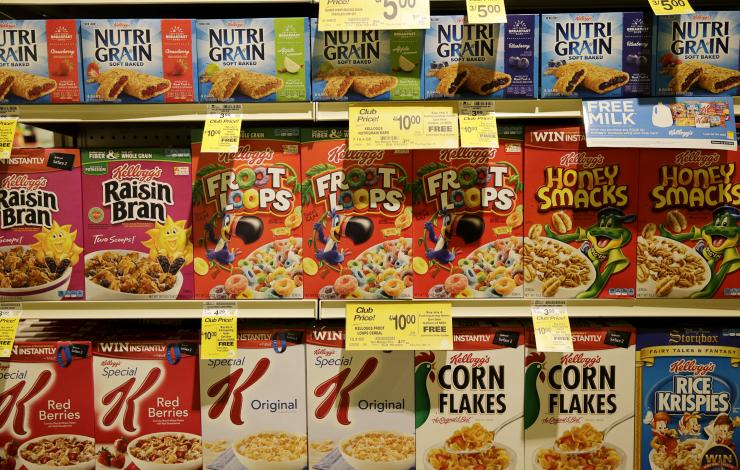Obesity experts urge Senate to consider how unhealthy food is marketed to kids in obesity inquiry.
Kids’ snacks and breakfast cereals featuring cartoons or character promotions are almost guaranteed to contain too much sugar, new research from the Obesity Policy Coalition (OPC) has revealed.
Of the products containing cartoons or character promotions, the following contained more than 15 grams of sugar per 100 grams*:
- 100% of kids’ snack bars and packets (all 30 products surveyed)
- 78% of kids’ breakfast cereals (32 of 41 products surveyed)
- 17% of kids’ dairy snacks (9 of 53 products surveyed)
Even though not as many kids’ dairy snacks were high in sugar, this category held the worst offenders for amount of sugar per serve. A tub of Choc Yogo with m&ms, with its goofy cartoon gorilla on the lid, contains a whopping eight teaspoons of sugar (21% of the product).
“Kids are easily lured by fun, colourful characters on food packaging,” said OPC Executive Manager Jane Martin.
“But our children don’t need special ‘kid’ products. Our children need real, nutritious, whole foods, in the same way that adults do. The idea that children need specific ‘fun’ foods is nothing more than a marketing ploy to generate pester power in the supermarket.”
How the food industry has contributed to childhood obesity will be a focus of a parliamentary inquiry into Australia’s obesity epidemic. The inquiry will also examine evidence-based measures to prevent childhood obesity.
“Marketers are well aware kids have a lot of power over what parents buy, and they know cartoon characters have this pull,” said Ms Martin. “At a time when 27% of children are above a healthy weight and tooth decay is the highest cause of acute, preventable hospital stays for Australian children, it’s shocking to see food marketers blatantly push these sugar-laden products onto kids.”
Other sugary kids’ snacks included the Nice’n’Natural Fruit Frogs, which are 60% sugar, and the Scooby Doo Iddy Biddy Fruity Bits, which are 57% sugar (2.6 and 2.9 teaspoons of sugar per serve). Both Frosties and Goldenvale Tweety’s Honey Wheats breakfast cereals are around 40% sugar (3.1 and 2.9 teaspoons per serve).
For maximum health benefits, the World Health Organization recommends adults consume no more than six teaspoons of added sugar, including fruit concentrate, in a single day. Children should consume even less.
It’s not just the packaging that’s been carefully designed to tempt children – the sugary products themselves are also designed to keep kids coming back for more, Ms Martin said.
“When children regularly consume sugary foods and drinks, their palates become sweeter and their tastebuds adjust,” Ms Martin said. “Eating too much sugary food is particularly problematic during a child’s crucial developmental years, as they also miss the opportunity to develop a taste preference for healthier foods. This type of unhealthy food marketing is undermining efforts by parents, schools and communities to encourage healthy habits.”
Ms Martin said the OPC wants to see a compulsory, strengthened Health Star Rating System that recognises that sugar processed from fruit is still sugar, and rates products accordingly.
The OPC is also calling for clear ‘added sugar’ labelling on the packaging, which includes sugar from fruit pastes and concentrates, and a 20% health levy on sugary drinks.
Submissions to the parliamentary inquiry into Australia’s obesity epidemic are open until 6 July, with a report due 14 August.
About the analysis
This OPC survey looked at 53 dairy snacks, 30 snack bars, and 41 breakfast cereals that featured cartoons or character promotions.
*The analysis was conducted using the Australian Department of Health’s recommendations around limiting foods with sugar more than 15 grams of sugar per 100 grams. Foods that did not meet this threshold were considered high sugar.
About the Obesity Policy Coalition
The OPC is a partnership between Cancer Council Victoria, Diabetes Victoria and the Global Obesity Centre at Deakin University, a World Health Organisation Collaborating Centre for Obesity Prevention. The OPC advocates for evidence-based policy and regulatory change to address overweight, obesity and unhealthy diets in Australia.
The most sugary kids’ foods using cartoon and character promotions
Foods with the most sugar per serve in each category, according to the analysis.
|
SNACK BARS AND PACKETS |
Sugar per serve (tsp) |
% Sugar |
| Nice and Natural Raspberry Fruit Frogs
136ml pack; 17ml serve |
2.6 |
60.3 |
| Hot Shots Fruit Tails Duos: Orange and raspberry
160ml pack; 20ml serve |
3.0 |
59.5 |
| Hot Shots Scooby Doo Iddy Biddy Fruity Bits
160ml pack; 20ml serve |
2.9 |
57 |
| LEDA Dunk-ies
135ml pack; 22.5ml serve |
2.5 |
43.7 |
| Moo Free Limited MiniMoos Bunnycomb bars
75ml pack; 25ml serve |
2.5 |
40.5 |
|
CEREALS |
Sugar per serve (tsp) |
% Sugar |
| Kelloggs Frosties
350ml pack; 30ml serve |
3.1 |
41.3 |
| Aldi Goldenvale Tweety’s Honey Wheats
750ml pack; 30ml serve |
2.9 |
39 |
| Kelloggs Froot Loops
500, 285ml packs; 30ml serve. 25mL fun pack serve |
2.9 2.4 in fun pack size |
38 |
| Kelloggs Coco Pops Chex
500ml pack; 30ml serve |
2.8 |
37.4 |
| Kelloggs Coco Pops
375ml pack; 30ml serve. 25mL fun pack serve |
2.7 2.3 in fun pack size |
36.5 |
|
DAIRY SNACKS |
Sugar per serve (tsp) |
% Sugar |
| Lion YoGo Choc YoGo and mini m&ms
150ml tub serve |
7.8 |
20.8 |
| Munchables Choc mousse
12x pack; 50ml serve |
2.4 |
18.8 |
| Aldi Brooklea Chocolate Stampede dairy snack
140ml tub serve |
6.5 |
18.6 |
| Pauls Milky Max Chocolate dairy snack
12x pack; 100ml tub serve |
4.5 |
17.8 |
| Aldi Brooklea Chocolate Stampede dairy snack
100ml tub serve |
4.2 |
16.8 |
| Coles Choc Snack
12x pack; 100ml tub serve |
4.1 |
16.2 |
This information is accurate as of September 2017.



